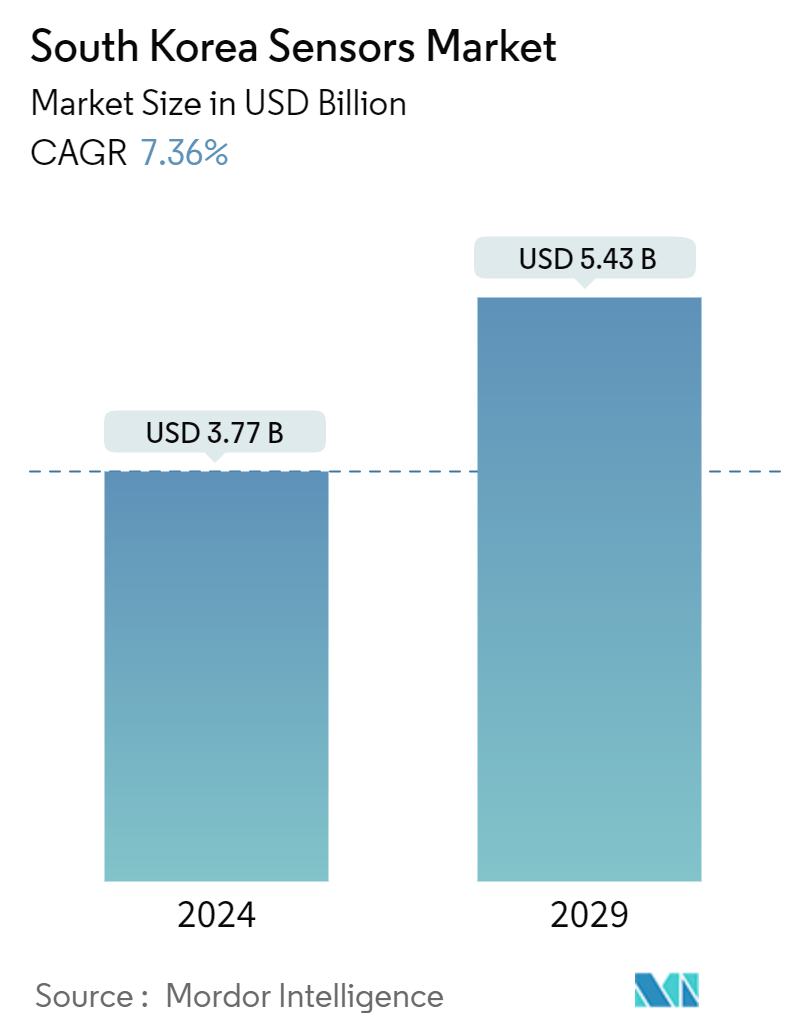Market Size of South Korea Sensors Industry

| Study Period | 2019 - 2029 |
| Base Year For Estimation | 2023 |
| Market Size (2024) | USD 3.77 Billion |
| Market Size (2029) | USD 5.43 Billion |
| CAGR (2024 - 2029) | 7.36 % |
| Market Concentration | Low |
Major Players
*Disclaimer: Major Players sorted in no particular order |
South Korea Sensors Market Analysis
The South Korea Sensors Market size is estimated at USD 3.77 billion in 2024, and is expected to reach USD 5.43 billion by 2029, growing at a CAGR of 7.36% during the forecast period (2024-2029).
- The surge in IoT technology has heightened the demand for sensors. Sensors are pivotal in collecting data from the physical world and enabling seamless communication among devices and systems. The growing importance of IoT in South Korea has resulted in a notable increase in the compatibility of sensors with IoT platforms, allowing for easier remote monitoring and control. This advancement in IoT-connected devices has created numerous opportunities for sensors in the industrial, medical, consumer electronics, automotive, and other sectors.
- The rise of automation in South Korea is expected to increase the need for sensors as they are essential in detecting, analyzing, measuring, and processing various changes, including shifts in position, length, height, surface, and movement in industrial manufacturing settings. Focusing on smart manufacturing, the Korean administration aims to set up 30,000 fully automated manufacturing firms by 2025. These firms will leverage advanced technologies like automation, data exchange, and IoT. Such initiatives are poised to significantly boost the demand for sensors in the country.
- The rise in sensor usage among smart device makers, coupled with a surge in the desire for superior image quality, is fueling the necessity for sensors across multiple sectors, including consumer electronics, automotive, defense, and healthcare. The increasing automation of manufacturing systems in discrete and process industries has also increased the need for components that deliver essential production process data. These sensors are crucial to improving factory process control by detecting the presence and position of metallic objects.
- The growth of various industries that utilize sensors has increased the demand in the country. In South Korea, there is a strong demand for sensors used in health applications, as there are ongoing concerns about the health of the population due to the increasing prevalence of chronic diseases. One of the key factors driving the necessity for sensors is the growing popularity of wearable health devices for monitoring patients.
- Market growth is expected to be hindered by the substantial costs of installing and maintaining smart sensors. The adoption of smart sensors has been slow, primarily because of the expensive components and batteries that drive the overall cost. Integrating sensors into existing systems can be challenging due to compatibility issues. The need for specialized knowledge is also impeding the market's growth. In addition, developing advanced sensor technologies often requires substantial research and development (R&D) investments, which can be a barrier for small companies.
- Macroeconomic factors like economic downturns can reduce business and consumer spending, leading to lower demand for sensor-equipped products and low investments in new technologies. Fluctuations in energy prices can influence the cost of production and transportation, impacting the overall cost structure for sensor manufacturers. In addition, tariffs, trade restrictions, and policies can impact the distribution and pricing of sensors, affecting the market dynamics.

